KING MONGKUT AND THE REALISTIC COSMOLOGICAL IDEA AT THE MAIN STUPA OF WAT BAVORNNIVET
Keywords:
Main Stupa, Wat Bavornnivet, Centre of the universeAbstract
During the years under the reign of King Mongkut, sciences and technologies of the western world were highly improving thanks to the Industrial Revolution in 18th century. King Mongkut of Siam was a great king of visionary. His Highness was aware of the necessity of adaptation to the arriving global changes. He knew that the changes of his country, in aspects of both technologies and social administration, were inevitable. Even in the religious aspect, His Highness reformed the secular Buddhism of Siam into the new sect dedicated to the pure doctrine and abolished the profane practices.
The main stupa of Wat Bavornnivet was the suitable example of this reformation. It exemplified the integration of modern worldview and indigenous belief of Thai people. The animal sculptures around the four corners of the sacred pond, Anotatta, and also encircled the sacred Mount Meru, which was believed to be the centre of the universe, were replaced with new set of sculptures containing new symbolic meaning. Lion represented the British Royal House; Horse represented the French power; Eagle represented the democratic world of the United States; and finally Elephant represented the Lan Chang Kingdom (with the Bunch of Grain represented Lanna Kingdom) -- all of these connotations were the signs of paradigm shift from old belief of Triphum, which literally means three realms: earth, heaven, and hell, into the colonialistic mindset. At the same time, the Main Stupa signified the centricity of Buddhism and from the Stupa itself the other implication could be made, the Declaration of Siam over the infidels as well as its underlings.
References
ไกรฤกษ์ นานา. (2550). สยามกู้อิสรภาพตนเอง : ทางออกและวิธีแก้ปัญหาชาติบ้านเมืองเกิดจากพระราชกุศโลบายของพระเจ้าแผ่นดิน. กรุงเทพฯ : มติชน.
ไกรฤกษ์ นานา. (2547). การเมือง “นอกพงศาวดาร” รัชกาลที่ 4 พระจอมเกล้ารู้เท่าทันตะวันตก “มิตรภาพอาบยาพิษ.” กรุงเทพฯ : มติชน.
ไกรฤกษ์ นานา.(2550). สมุดภาพรัชกาลที่ 4 : วิกฤติและโอกาสของรัตนโกสินทร์ในรอบ 150 ปี. กรุงเทพฯ : มติชน.
เจ้าพระยาทิพากรวงษ์มหาโกษาธิบดี (ขํา บุนนาค). (2514). หนังสือแสดงกิจจานุกิจ. พระนคร : องค์การค้าของคุรุสภา.
ณัฏฐภัทร จันทวิช. (2549). ศิลปกรรมแบบพระราชนิยมพระบาทสมเด็จพระจอมเกล้าเจ้าอยู่หัว, กรุงเทพฯ : กรมศิลปากร.
ทองต่อ กล้วยไม้ ณ อยุธยา. (2547). เล่าเรื่องพระจอมเกล้า. นครปฐม : โรงพิมพ์มหามกุฏราชวิทยาลัย.
ประชุมพงศาวดาร เล่ม 15 (ประชุมพงศาวดาร ภาค 25-27). (2507). กรุงเทพฯ : คุรุสภา.
พัสวีสิริ เปรมกุลนันท์. (2552). “ปิดหน้าต่าง-ประตู ดูจิตรกรรมรัชกาลที่ 4 เรื่องวินัยสงฆ์.” ดํารงวิชาการ 8, 2.
“พระราชหัตถเลขา ถึงมิสเตอร และมิสซิซ เอ็ดดี.” อ้างจาก จอมเกล้าเจ้าอยู่หัว, พระบาทสมเด็จพระ. (2521). พระราชหัตถเลขาพระบาทสมเด็จพระจอมเกล้าเจ้าอยู่หัว. กรุงเทพฯ: มหามกุฎราชวิทยาลัย.
วรรณิภา ณ สงขลา. (2533). จิตรกรรมไทยประเพณี เล่ม 1. กรุงเทพฯ : โบราณคดี กรมศิลปากร.
วัดบวรนิเวศวิหาร. (2551). สมุดภาพพระเจดีย์วัดบวรนิเวศวิหาร. กรุงเทพฯ : สุรวัฒน์.
สํานักราชเลขาธิการ. (2528). ตํานานวัดบวรนิเวศวิหาร (เล่ม 3). กรุงเทพฯ : โรงพิมพ์กรุงเทพฯ (1984).
สันติ เล็กสุขุม. (2552). “จิตรกรรม (ณ ศูนย์กลางจักรวาล) ปรัมปราคติกับการแสดงออกอย่างใหม่.” งานวันพระบาทสมเด็จพระนั่งเกล้าเจ้าอยู่หัวประจําปี 2552 “พระนั่งเกล้าฯ กับความเป็นศูนย์กลางจักรวาลของวัดสุทัศน์ฯ.” ฝ่ายศิลปวัฒนธรรม มหาวิทยาลัยศิลปากร.
David Williamson. (1991). King and Queen of Britain. London: Webb and Bower.
Prince Michael of Greece. (1990). Crown jewels of Britain and Europe. London : Peerage Books.
Downloads
Issue
Section
License
บทความนี้เป็นผลงานของข้าพเจ้าแต่เพียงผู้เดียว และ/หรือเป็นผลงานของข้าพเจ้าและผู้ร่วมงาน ตามชื่อที่ระบุในบทความจริง และเป็นผลงานที่มิได้ถูกนำเสนอหรือตีพิมพ์ที่ใดมาก่อน





